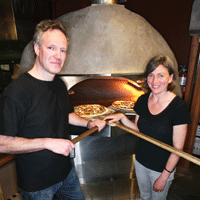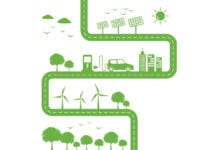Suzanne and Dominic Fielden of Rocky Mountain Flatbread, earn the 2012 F&H Green Leadership Award for integrating sustainable practices into their pizza business
Married with a growing family, Suzanne and Dominic Fielden dreamed of opening a green business. Now, nearly 10 years later, Rocky Mountain Flatbread Co. is a sustainable operation with three restaurants in British Columbia and Alberta and a retail line of pizzas and breads.
Tell me a little bit about the company?
Dominic Fielden: We started the company in May 2004 in Canmore, Alberta, but the idea originated a few years before when we were consultants in the U.K. Both of us are passionate about social and environmental responsibility and came upon the idea of setting up a food business, more specifically a pizza business, that needed to be not only financially responsible, but also socially and environmentally responsible. If either one of the three cornerstones of the business wasn’t fulfilled then we would have failed as a business. We chose food, because both of us are passionate about it, and we chose pizza because it’s something people eat on a regular basis. It’s not really class-oriented; everyone likes pizza.
What does going green mean for your company and for you personally?
Suzanne Fielden: It was the mission of our business to demonstrate how you make money, while making an environmental and a social difference. It wasn’t something we started once we embedded the rest of our business. It was at the heart of it when we opened. It guided our decisions. So when we’re building our restaurants we use reclaimed wood; when we’re sourcing our suppliers [it’s] local, if possible. We compost everything, and we designed our menu with a zero-waste [mandate] so that we have minimal waste. It’s really integrated into every orifice of our business. We also have posters and we get involved in the community; on our tabletops we have little info cards about how you can reduce your carbon footprint or how you can buy Ocean Wise seafood or connect with your local farmer’s market. For us it’s a community thing, and it affects the youth, our diners, our community, like-minded individuals, and organizations. We’re trying to get everyone involved in the movement.
DF: It’s looking at the most impressive players in the marketplace, with regard to their financial ratios, and [determining] how we can achieve the same or better ratios while providing a product that is organic, all-natural, locally sourced and tastes great.
SF: It [goes back to] our zero-waste menu. We have daily specials, we use a lot of local produce and our soups, pizzas, salads and pastas have similar ingredients. Restaurants often have a lot of meat or seafood that doesn’t move fast enough, and food gets thrown away — it’s not designed into the menu. If you don’t design it in the beginning, you’re going to have a lot of waste.
“It was the mission of our business to demonstrate how you make money, while making an environmental and a social difference. It wasn’t something we started once we embedded the rest of our business. It was at the heart of it when we opened. It guided our decisions.”
What are your key green initiatives?
DF: All the initiatives that educate our society are key to our business, because that’s our community outreach. A lot of companies, especially in the food business, will spend a lot of money [distributing] coupons and deals and telemarketing and mail-outs. We’ll spend our promotional marketing money on community initiatives and working in schools. A major part of our success, and our green initiative, is empowering others to do great things for themselves and their community
SF: We work with a school from the beginning to the end of the year, and we teach winter gardening, spring gardening, winter crafting. It creates real culture change in the school — 600 kids and parents start buying differently, teachers start buying differently and they start growing their own food. Our second biggest green initiative is our food sourcing, because the average [distance food] travels is one of the biggest environmental footprints. We partner and continue building on it. In the summer our beans and our sprouts come from Vancouver and most of our produce, probably about 60 to 70 per cent in the summer, is coming from Delta and the Fraser Valley, so within 100 miles. Our seafood is Ocean Wise and our meats are local and organic. We’ve even started growing our own sprouts in the restaurant to top our salads.
DF: [The restaurant] was built to last. Our flooring is concrete. We don’t have to lay a carpet that needs to be replaced every three to five years. This concrete floor is going to last probably longer than the building. And, the LED light bulbs are going to last 10 to 15 years.
What do you say to people who think greening is too expensive?
SF: It’s not expensive at all.
DF: You just have to think differently. If you compare an LED to a regular light bulb, an LED may be $50 and a regular light bulb may be $7. So you look at the initial investment and that puts a lot of people off. But if the community is supportive — for example, in Vancouver, B.C. Hydro is [giving] grants to convert light bulbs in our washrooms — I think it must have been 70 or 80 light bulbs for about $4,500, which is a lot of money for a small business, but B.C. Hydro gave us a grant for about 80 per cent of that. So, if you dig a little deeper, there are ways of making it cheaper.
How has your green commitment contributed to the environmental cause and your bottom line?
SF: [By] creating an integrated menu with seasonal produce we are able to boast a 22-per-cent food cost when the industry norm is between 25 and 32 per cent. We also save money and carbon through making everything in-house. Our lemonade, iced tea, brownies, dough, tomato sauce, dips, sautéed veggies, gluten-free pasta, gluten-free pizza shells, ravioli, et cetera, save tons not only in packaging but in food miles. We save $659 a year per restaurant in electricity through swapping to LED lights. And we save $200 a year, per restaurant, by changing halogen light bulbs. Our pizza-box packaging is made from 100-per-cent recycled fibres — saving 204 trees a year. We also offset our gas and electricity through purchasing offsets from a wind power farm in the Elk Valley, [B.C.] and a landfill in Quebec. We offset 240 tonnes a year, allowing us to be carbon neutral as a group of three restaurants. Our napkins are made from 100-per-cent recycled materials, too, and our take-out packaging is made from sugar-cane waste — saving another 102 trees a year. We also divert 55 tonnes of waste from our landfills through composting.
Do you have any certification from a governing board or independent auditor?
SF: Yeah, we’ve just been through the Climate Smart training, so they coach you on how to calculate your carbon footprint, and then they review it and challenge and question. We also have Bullfrog Power and Offsetters come in to look at our carbon footprint and inform us how much we need to offset by. Climate Smart is the most formal, and it’s a rigorous two weeks of work, [determining] what you’re diverting where, and how many food miles your food is travelling, how many trees you’re impacting by your paper use.
DF: When we first opened the Kitsilano restaurant, we had an eco auditor come in to work out our carbon footprint here; so Climate Smart is an extension of that. We’re also part of Green Table Network in Vancouver, and they have metrics and great resources online to help and support organizations become greener.
What advice do you have for restaurateurs trying to reduce their carbon footprint?
SF: Start small and just do something. Do anything, because there’s so many opportunities out there, from changing your paper to creating composting systems to changing your light bulbs and getting a grant — or when you’re redesigning your menu look to have a more integrated menu, a more seasonal menu.
DF: Definitely go to Green Table’s website, and join that network. Get Ocean Wise fish in.
What’s the greatest challenge in running a sustainable restaurant?
SF: It’s always balancing making money, having great service and running your restaurants with your social and environmental work — you’ve got to make it full circle. That social and environmental difference distinguishes you from other restaurants or hotels.
Are there any green initiatives you’re hoping to implement soon?
SF: It’s small stuff every day. It’s always looking out and having meetings with farmers and farmer’s markets, organizations. It’s not radical. It’s not always strategizing. It’s pretty simple stuff. You just have to go at it every day; it’s a way of doing business.
What are your plans for the future?
SF: We’re always looking for innovative ways to reduce our carbon footprint, so we don’t just have to offset. [We’d like to be part of] a growing movement of organizations that aren’t just in business to make money; they’re in business to really make a difference and a contribution to helping our environment and helping our communities socially.
DF: The ambition is to engage as many people in this conversation as possible.
photo courtesy of Randall Cosco
Keep Reading
Cluck, Quack, Gobble or Chicken, Duck and Turkey are Inspiring Chefs
Greening Your Foodservice Business
Money Talks: Financial Projections for New Restaurants
Attend the Top 100 + Top 50 + Green Leadership Awards 2012





















